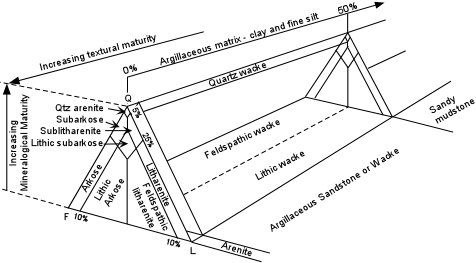
| Geology 212 | Petrology |
Prof. Stephen A. Nelson |
Sandstones & Conglomerates |
||
Sandstones Sandstones make up only about 25% of the stratigraphic record, but have received the most attention in studies of sedimentary rocks. There are basically two reasons for this. First, sandstones are easily studied because they contain sand sized grains that can easily be distinguished with a petrographic microscope. Second, most of the world's oil and natural gas is found in sands or sandstones because of their generally high porosity. Classification |
| Sandstones that contain less than 10% clay matrix are called arenites (note that the Spanish word for sand is arena). These can be subdivided based on the percentages of Quartz, Feldspar, and unstable lithic fragments (fragments of preexisting rock). |  |
| A feldspar-rich sandstone is called an arkose. Lithic rich sandstones are called
litharenites. Further subdivisions are shown in the diagram. If the rock has between
10 and 50% clay matrix, the rock is called a wacke. Quartz wackes have predominantly
quartz surrounded by a mud or clay matrix. In a feldspathic wacke, feldspar is more
abundant, and in a lithic wacke, lithic fragments are more abundant. The term graywacke
is seldom used today, but was originally used to describe a lithic-rich sandstone with
between 10 and 50% mica, clay, or chlorite matrix. Rocks with greater than 50% clay
matrix are called sandy mudstones, and will be discussed in the lecture on mudrocks. As
the percentage of quartz increases, the mineralogical maturity of arenites
increases. Also, as the percentage of clay matrix decreases the degree of sorting
increases, and thus the textural maturity increases. Textural maturity also increases
in the opposite direction as the % clay matrix increases from 50 to 100%. |
| Mineralogic Composition of Sandstones As seen in the classification scheme, sandstones are composed of mostly quartz, feldspar, and lithic fragments. Other minerals also occur, depending on the mineralogical maturity of the sandstone. It is these minerals that make studies of the provenance (origin of the grains) possible in the study of sandstones. Here we discuss the common minerals in sandstones as well as the less common (accessory) minerals.
Quartz occurs as both monocrystalline grains and polycrystalline grains, and usually
shows undulatory extinction (see figure 13-6, p. 247 in Blatt and Tracy). The
undulatory extinction is due to deformation either of the preexisting rock from which the
grains were derived or results from deformation of the sandstone itself. Thus, even
though some workers claim that quartz showing undulatory extinction is derived from a
metamorphic source, such quartz cannot be a reliable indicator of a metamorphic source.
|
|
Provenance of Accessory Minerals in Sandstones Igneous Source Metamorphic Source Indeterminate Source Aegerine
Augite
Chromite
Ilmenite
TopazActinolite
Andalusite
Chloritoid
Cordierite
Diopside
Epidote
Garnet
Glaucophane
Kyanite
Rutile
Sillimanite
Staurolite
TremoliteEnstatite
Hornblende
Hypersthene
Magnetite
Sphene
Tourmaline
Zircon
Example: Sands in the Gulf of Mexico A modern example
serves well to show how studies of heavy minerals could help to determine the source of
sands in ancient rocks. Sands in the Gulf of Mexico can be divided into 5 provinces
based on their source, which of course is known for modern sands since we can trace the
streams draining into the Gulf back to the areas that they drain. But, because the streams
drain areas with different geological and mineralogical characteristics, heavy
mineral assemblages are different for each. |
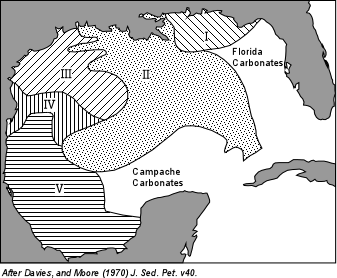 |
|
|
| Tectonics and Sandstone Compositions The main factor that creates the basins necessary to form clastic sedimentary rocks is tectonics. Once a basin is formed, the area surrounding the basin will shed its erosional debris and the sediment transported and deposited could form a sandstone. Clues to the tectonic setting in which the basin formed may be left in this accumulated sediment. Sediments formed from a magmatic arc that has not undergone extensive erosional dissection should consist of a high proportion of volcanic lithic fragments that contain a high ratio of plagioclase to alkali feldspar. With increasing erosional dissection, more plutonic rocks will become exposed and the sediment shed will contain a higher proportion of quartz and alkali feldspar. |
| Sands derived from sources on continental blocks could come from two
tectonic settings. If the continental block has recently split as a result of
continental rifting, the sands will be quartzo-feldspathic with high ratios of alkali
feldspar to plagioclase. If the sands are derived from high topographic areas
located long distances from the depositional areas, the sands will be more quartz rich,
showing a higher degree of mineralogical maturity. |
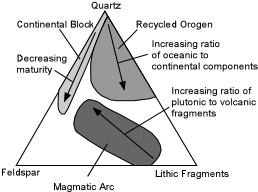 |
| If the source area has recently undergone a major orogenic event, the sands will
contain a significant fraction of lithic fragments, with more lithic fragments being
derived from parts of the orogenic belt rich in oceanic components and less lithic rich
sands from continental sources. Climate and Sandstones |
| Since climate controls the weathering processes, with deeper more intense
weathering occurring in humid climates than in arid climates, we might expect to see
differences in the these conditions showing up in the sediment. Looking at modern sands
derived from plutonic igneous rocks, we find that humid climates produce sands with higher
proportions of quartz and lower proportions of lithic fragments than do semiarid climates.
Similarly, for sands derived from metamorphic source rocks, humid climates produce more
quartz rich sands than do semiarid climates. |
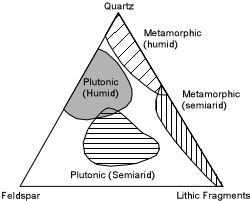 |
| Diagenesis of Sandstones Once sand has been deposited and buried by more sediment, it begins to undergo diagenetic processes which can turn the unconsolidated material into a sedimentary rock. There are seven main diagenetic processes:
Note that diagenesis is not restricted to sandstones and conglomerates, but occurs in carbonates and mudrocks as well.
|
|
Quartz cement often occurs as overgrowths on the original quartz grains. These overgrowths grow in crystallographic (and optical) continuity with the original quartz grains. The overgrowth cement grows outward from the original grain until it runs into cement growing outward from an adjacent grain. Thus, the rock attains a texture of interlocking grains similar to an igneous crystalline granular texture. If the grain has small specs of clay or other fine grained dirt forming an irregular coating on its surface, the coating may be preserved and show the original outline of the grain. (see also fig. 14-2 p. 267 in your text) |
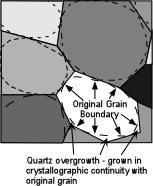 |
|
|
|
Often times when these cements form near the Earth's surface, the cementing minerals form crystallographically continuous crystals in the cement, resulting in Sand Crystals. Such crystals are usually made mostly of grains of quartz sand, but have the appearance of a crystal (like a barite rose, a gypsum rose, or calcite crystal) only because the cement between the grains forms a crystal. If you were to cut a thin section of such a sand crystal you would see that the cement is optically continuous between the grains (i.e. it would all go extinct at the same time). |
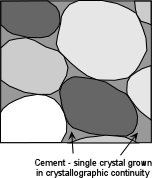 |
|
Conglomerates A coarse grained siliclastic rock with a muddy or sandy matrix is called a diamictite, conglomerate, or breccia. Conglomerate and Breccia are the more widely used terms. In a conglomerate the large clasts are rounded, whereas in a breccia the clasts are angular. |
| Further classification of such rocks can be made on the basis of the proportions of gravel size material (pebbles, cobbles and boulders), mud (silt and clay sized), and sand, as in the diagram shown here. | 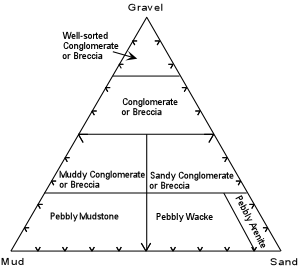 |
| Because the clast size can range from pebble size to boulder size, the rock fragments
that make up the clasts can be easily identified and described, and can thus provide
detailed information on the provenance of the sediment. Such coarse grained rocks can be deposited by rivers, glaciers, landslides, ocean and lake waves, and can occur as pyroclastic rocks. Although such rocks make up less than 1% of the sedimentary record, they are important because they are usually porous and permeable and can be excellent reservoirs for water and petroleum, In addition, they often form valuable placer ore deposits because they contain high concentrations of heavy minerals, including gold. |
| Return to Geology 212 Home Page |